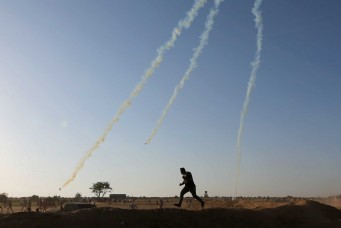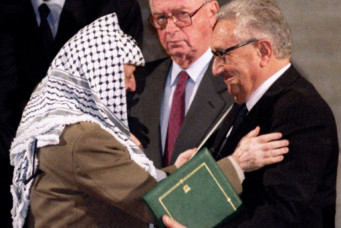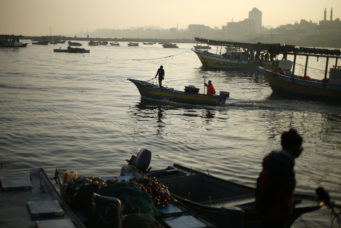Gaza Conflict Cascading Effects: The Rafah Question

Egypt has described the latest suggestions by members of the Israeli Knesset for a “voluntary emigration” of Palestinians across the world as a “full-fledged war crime”. Foreign Minister Sameh Shoukry lambasted the idea—endorsed by Israeli Finance Minister Bezalel Smotrich—and said that Israel’s “deliberate targeting” of civilians is tantamount to a forced evacuation.
The idea that Palestinians should find somewhere else to call home has resurfaced as Israel’s bombing of Gaza enters its sixth week, having killed over 11,000 Palestinians, the majority of whom were women and children, and entirely destroyed the healthcare system in the besieged enclave.
But Israel has rejected appeals by global leaders for a ceasefire, or humanitarian pause, as conditions continue to worsen for 2.3 million Gazans. United Nations officials have condemned the carnage in Gaza and along the Rafah crossing, with Secretary-General António Guterres pleading for relief of the aid “lifeline” along the borders.
The Rafah border crossing, where desperate Palestinian families are seeking to cross into Egypt, has now become a focal point. The Egyptian government opened the crossing, allowing only the most dire medical cases and foreigners to be evacuated, contingent on the security situation. Repeated Israeli bombing of the Palestinian side of the border crossing, and targeting ambulance convoys led to the occasional suspension of operations at the border.
Israeli officials have in recent weeks eyed Rafah as an exit point for resettling Palestinian refugees from Gaza into Egypt. The Israeli Defense Forces (IDF) first floated the idea on October 13, when they suggested that 1.1 million Palestinians should take refuge in the southern part of the Gaza Strip, neighboring the Sinai Peninsula. Israeli Prime Minister Benjamin Netanyahu endorsed it.
Egypt vehemently opposed Netanyahu’s proposal and ruled out any possibility of Israeli ambitions for Sinai to be an alternative home for displaced Palestinians.
Nevertheless, Israeli Ambassador to the United States Danny Ayalon said on October 15 that the “endless space” in the Sinai Peninsula could provide a temporary residence for potential refugees until military operations in Gaza subside. Ayalon further suggested that the international community join hands with Israel to provide tent cities and proper infrastructure to host asylum seekers.
But such a proposition parallels the 1948 Nakba during the first Arab-Israeli War when 700,000 Palestinians fled Israeli attacks and massacres, and were permanently expelled to Jordan, Syria, and Lebanon.
Egyptian President Abdel Fattah El-Sisi repeatedly warned against such a scenario, stressing that it would transform the entire region into a “ticking bomb.” His warning was reflected on social media and in the streets, with many Egyptians expressing fury over perceived imminent threats to Egypt’s national security and the liquidation of the Palestinian cause.
The Genesis of the Rafah Question
The Sinai Peninsula, located in northeast Egypt, shares a 12.8-kilometer border with the Gaza Strip. This has made the Rafah border crossing an expedient outlet for crises that occur in Gaza, which has been under a punitive embargo and fraught with conflict for years.
The Israeli decision for the unilateral disengagement from Gaza in 2005 ended its 38-year occupation of the enclave; joint control over the Rafah border was then transferred to Egypt and the Fatah-controlled Palestinian Authority, who granted restricted passage to Palestinian nationals on a humanitarian basis.
Pursuant to the 1979 Egypt–Israel peace treaty, the Philadelphi Corridor, also known as Salah Al-Din Road, a narrow strip of land spanning 14.5 kilometers, nestled between the Strip and Egypt, came to serve as a buffer zone between Israel, Egypt, and Gaza. Israeli forces patrolled the border to prevent the smuggling of weapons and infiltration of people between Egypt and the Gaza Strip. To facilitate Israeli evacuation from the Philadelphi Corridor, Egypt and Israel signed the Philadelphi Accord, stipulating that Egypt deploy up to 750 border guards to patrol its side of the border.
For the first half of 2006, the crossing was open more than nine hours a day, with an average of 650 people crossing daily but after the abduction of Gilad Shalit, an Israeli soldier, by Hamas, the border was closed on June 25, 2006, and has only been opened sporadically for limited cases since then. Israel barred European Union observers who had kept close watch of the border since November 2005 from accessing the crossing, and it was never opened again to allow for the passage of goods.
The Philadelphi Accord collapsed; it had initially been designed to open the Gaza–Egypt border for restricted passage of Palestinian residents and the export of agricultural goods from Gaza. Further promises included the construction of a Gaza Seaport, a link between Gaza and the West Bank, and more freedom of movement within the West Bank. As none of these promises were fulfilled, tunnels were built by Hamas and other groups on the Palestinian and Egyptian sides to smuggle people, medicines, and material to and from the Gaza Strip.
The Philadelphi Accord failed to regulate the passage of people and goods along the borders, and left the Corridor lacking a binding security agreement. Looming was also the question of the Palestinian leadership’s ability to fill the void created by Israel’s departure, leaving a vacuum to be filled by Hamas.
Following the 2004 death of Yasser Arafat, former Chairman of the Palestine Liberation Organization, standoffs between the two major Palestinian armed factions, Fatah and Hamas, surfaced. Hamas, established in 1987 as an offshoot of the Muslim Brotherhood, took advantage of the January 2006 Palestinian legislative elections and rose to power by winning the ballot box. Ismail Haniyeh-led Hamas, however, refused to recognize Israel—in contravention of Fatah’s position—which led to international condemnation. Efforts to form a national Palestinian government collapsed and Fatah nullified the election results. The divide between the two factions continues to this day with the de facto separation of powers: Hamas runs the Gaza Strip and Fatah governs in the West Bank, but confrontations between the two soon bubbled to the surface.
The 2007 “Battle of Gaza”
Armed clashes for dominion raged between Fatah and Hamas in the Gaza Strip between June 10 and 15 2007. In the midst of this political turmoil, Egypt closed the Rafah border crossing in June 2007, a few days before Hamas took full control of Gaza. The European Union monitors ended their oversight at the frontier on June 14 due to security concerns.The Palestinian Centre for Human Rights reported over 161 people slain and more than 700 wounded from those incidents.
Following the conflict between the two Palestinian factions, international sanctions imposed on Hamas since it came to power were replaced in June 2007 with a new and more severe blockade of the Gaza Strip. The Israeli government closed all checkpoints along its border with Gaza in response to the violence. With fuel supply reductions commencing in October of the same year, a rise in rocket attacks on Israel from Gaza instigated a full blockade by January 17, 2008.
Security Implications of the Gaza Blockade: The 2008 Breach
As a result of the suffocating blockade and embargo of the Gaza Strip, Hamas on January 23, 2008 blew up a section of the Rafah border crossing, causing a portion of the wall to crumble and Gazans flooded the crossing. The United Nations reported more than 750,000 Palestinians, around half of Gaza’s population, crossed over in search of vital staples( food and medicine) in Rafah and Al-Arish, spending approximately 250 million dollars over the span of five days.
In an attempt to curtail the influx of Palestinians, Egypt refrained from using force but denied travel far beyond Arish, withheld provisions to the city, and pledged to close the border after the Palestinians left. Soon after the Egyptian military rebuilt the wall, Hamas bulldozers broke through a section of the barrier and events culminated in the shooting of Egyptian border guards, killing one and injuring another.
In February, Egypt and the PA gained full control over the Gazan side of the Rafah crossing after Palestinian President and PA leader Mahmoud Abbas announced a renewed effort to implement the 2005 border agreement with Israel on managing and securing the border.
The Islamic State in the Sinai, Egypt’s Biggest Security Threat to Date
In the years that followed the 2008 tensions, the Egyptian Army sought to reinforce security within the Sinai Peninsula by demolishing tunnels used to facilitate the movement of suspected terrorists attempting to carry out attacks in the Sinai. With the fall of the Mubarak government in 2011 and the rise of the Muslim Brotherhood (MB)’s Mohamed Morsi to power in 2012, border restrictions were once again relaxed. Ties between the two Islamist groups date back to the establishment of Hamas amidst the First Intifada in 1987 as a spin-off of the Muslim Brotherhood in Egypt.
Following Morsi’s removal from power in 2013, the Egyptian army resumed demolishing any tunnels deemed a threat to national security, reducing them to a “few dozen”.
Within a few months, Egyptian troop fortifications were reinforced and the tunnels were flooded, stabilizing the borders in April 2013. Nevertheless, the number of underground tunnels in 2013 was estimated to have reached 1,200, where livestock, luxury goods, building materials, and weapons moved freely.
Egypt’s tightened security measures led to a violent response from the Islamic State, which sought to avenge the ousting of the MB from power in Cairo, and was rebranded to draw connections with the Sinai Province by adopting the name Wilayat Sinai. Extremist group Ansar Beit al-Maqdis (ABM) pledged allegiance to the Islamic State. Ever since, the extremist alliance redirected its operations against the Egyptian security forces and civilians through suicide bombings and assassinations. In response, the Egyptian military carried out a number of tactical strikes, namely “Operation Martyr’s Right”, which lasted from 2015 to 2018, and the ongoing “Operation Sinai” that started in 2018.
The need for cooperation with Hamas grew apparent in countering the looming threat of the Islamic State in the Sinai. The tide of reconciliation began to crest in March 2016, as a delegation from Hamas arrived in Cairo to open communication channels. This heralded the start of a new chapter in relations, marked by a public visit by Ismail Haniyeh to Cairo in January 2017, and another in September, after his election as the leader of Hamas in he which spoke of a new era of bilateral ties and pledged to respect Egyptian national security, along with increased security cooperation with the government. As a sign of goodwill, Hamas officially severed any association with the Muslim Brotherhood in 2017, in a bid to reconcile with the Egyptian government.
Proposals for Palestinians Forced Displacement
Given the Rafah crossing’s storied past, it is no surprise that it has become a contentious issue between Egypt and Israel, with Washington’s recent proposals regarding the future of Sinai heightening Cairo’s fears.
Former U.S. President Donald Trump in 2020 put forward his “Peace to Prosperity” plan, which envisioned Sinai as part of a political solution for the Palestinians. The 181-page plan, notoriously known as the “Deal of the Century,” claims an approach that builds on the two-state solution by leveraging a total of 50 billion dollars in international investments channeled to Jordan and Egypt to help ensure regional economic integration for Palestinians. A proposed share of $9 billion would go to Egypt if it pushes for the establishment of an industrial zone in Sinai for the Palestinians without granting them permanent residence. However, significant opposition to the plan stemmed from accusations of a U.S.-backed Israeli gradual annexation of Jerusalem, the Jordan Valley, and the “purchase” of Sinai. This made the “Deal of the Century” lose footing across Egyptian, Jordanian, and Palestinian governments and populations.
Although the term “deal” embedded in its title implies consent, the “Deal of the Century” is not independent from the complex two-fold forced displacement scheme, whereby Palestinians would be forced to relocate to Sinai—a de facto strategy to force Egypt to give up the Sinai.
Following October 7, the issue of forced displacement manifested itself in direct and indirect Israeli pressure: outright offers to clear Egypt’ debts in exchange for its acquiescence. A “concept paper” conducted by the Israeli Intelligence Ministry on October 13, only six days after hostilities broke out, consolidates Israeli ambassador Ayalon’s aforementioned statement to build “tent cities” to host refugees. The paper proposes the resettlement of 2.3 Gazans in “permanent cities” in Sinai, then blocking the entry of Palestinians in the Israeli territories through a security zone, without identifying the fate of the cleansed Gaza Strip.
Egypt is also indirectly under pressure to alleviate the humanitarian crisis unraveling at the Rafah border as Israel continues to tighten its noose around Gaza. When Israeli forces warn densely populated areas before carpet bombing alleged Hamas bunkers underneath as a justification, Egypt is indirectly thrust into the conflict. Asking civilians to seek refuge in southern Gaza, the closest access point to Egypt, inevitably creates the needed spatial proximity to force Cairo to respond to a refugee exodus and unfolding humanitarian crises.
Egypt’s Security Fears
This also translates into a series of significant security challenges which Egypt would have to face.
An exodus of Palestinians to the Sinai would not be an exact re-do of the 2008 breach incident, because it has far-reaching and more serious security implications. The economic blockade of 2007 caused the Rafah border breach, and marked a precedent for Egypt when it realized that unforeseen escalations from politico-economic implosions within Gaza and at its borders could spill into Egypt. Swift containment by Egypt was manageable at the time through restriction of commodity supply, mending the Rafah fence, and sealing borders.
Conversely, the recurrence of such an event amidst a raging war increases the chances of a violent slippery slope, revealing stark differences between the 2008 and 2023 cycles of violence. Currently, the number of Palestinians the plan would forcibly expel surpasses 2 million people, while the 2008 breach witnessed an influx of tens of thousands. Furthermore, the 2017 rapprochement between Egypt and Hamas will likely be insufficient to manage and provide security for millions of Palestinians without restricting some movement in Sinai to prohibit armed groups from reining freely.
El-Sisi warned that such scenarios would transform Egypt into a “base for operations against Israel” and henceforth a pretext for Israeli counterterrorism operations on Egyptian soil. This, in turn, would unravel a decade of arduous counterterrorism missions carried out by the Egyptian military.
The closest analogy of the current war is in the aftermath of the 1948 Arab-Israeli War which not only created the Nakba but rewrote the region’s modern history, which has since then been steeped in nearly perpetual conflict.
Egypt is also aware that current Israeli proposals to end the conflict speak to simmering fears of the demise of the Palestinian cause, a fear shared by El-Sisi during a conference with Germany’s Olaf Scholz. Egypt is essentially concerned that another forced mass displacement would not be an issue in itself, rather a symptom of an imminent second Nakba.
While the threat of spillover of violence into the region in 2008 was negligible, the sheer magnitude of the current war—and Israel possibly moving forward with its forced expulsions—could pull neighboring countries into the conflict.
The geopolitical complexities of the war and Israeli ambitions to remove the Palestinians from Gaza appear to converge around the use of the Rafah crossing, bringing this vital gateway to prominence.
Although other approaches to de-escalation and long-term resolutions, such as the two-state solution, have been mainstays of decades-old Arab peace initiatives, Israel has rejected these notions and persisted with forced displacement proposals.
The prolonged crisis in Gaza feeds off a long-standing conflict entrenched in an unfaltering Israeli ultranationalist commitment to a radical demographic reshuffle in the Middle East.




